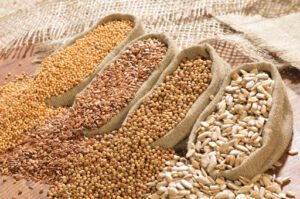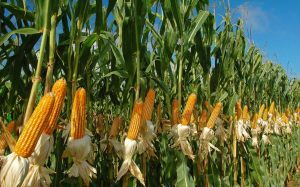
The production of grains and oilseeds in 2022 in Ukraine is preliminary estimated at 53.3 million tons, which is 51% lower than the record figure of the previous season, due to the Russian military invasion and ongoing hostilities, this year’s harvest may be the lowest in the last 10 -15 years.
“We estimate the total production of grains and oilseeds in 2022 at 53.3 million tons, which is 51% lower than the record figure of the previous season. At the same time, for grains, the harvest may be minimal over the past 15 years, and for oilseeds – over the last decade,” such harvest estimates are given on the website of the APK-Inform agency on Thursday.
The organization clarified that for the 2022 harvest, the area under winter grain crops decreased by 7% compared to last year – to 7.6 million hectares, which practically coincides with the figure for 2020. At the same time, the area under spring grain and leguminous crops, the sowing of which began this month, due to the occupation of part of the territories and hostilities by Russian invaders, can be reduced much more significantly – by 39%, to 4.7 million hectares.
In turn, the total area sown with oilseeds in Ukraine in 2022 may be about 6.8-6.9 million hectares, taking into account the areas already sown under winter rapeseed.
At the same time, a change in the structure of oilseed crops is expected. In particular, the share of sunflower acreage is projected to decrease from 73% in 2021 to 61% in 2022, while the share of rapeseed will increase from 12% to 21%, and soybean from 15% to 17%.
It is specified that as a result of hostilities, the sowing campaign in nine regions of the country looks very dangerous: Chernihiv, Sumy, Kiev, Kharkov, Luhansk, Donetsk, Zaporozhye, Kherson and Nikolaev. Partially risky areas for sowing are currently noted in Zhytomyr, Poltava and Dnepropetrovsk regions.
The agency emphasized that in addition to a decrease in the area under crops, a general decrease in crop yields is expected in Ukraine due to the limited access of farmers to the necessary resources, such as fuel, fertilizers, plant protection products, etc. However, even the projected volumes of crop production are enough to meet the domestic food needs of Ukraine .
As reported, as of March 25, Ukraine sowed 150,000 hectares of agricultural land in regions where there are no active hostilities against the troops of the Russian invaders.
Due to the military aggression of the Russian Federation in Ukraine, a decrease in the acreage of high-margin crops (sunflower and corn) is expected this season, while increasing the acreage of crops that are easier to produce, but important in terms of food security, peas, barley and oats.
In 2021, during the spring sowing season, Ukraine sowed 14 million hectares of agricultural land, including sunflower – 6.5 million hectares, corn – 5.3 million hectares, barley – 1.35 million hectares, peas – 0.242 million hectares, sugar beet 0.227 million ha, oats – 0.194 million ha, spring wheat – 0.176 million ha.

The U.S. Department of Agriculture (USDA) in its July report has improved the forecast for the production and export of Ukrainian wheat in the 2021/2022 marketing year (MY, July-June) by 500,000 tonnes compared to the forecast in June, to 30 million tonnes and 21 million tonnes, respectively.
In July, the USDA kept its forecast for corn exports from Ukraine in the 2021/2022 MY at 30.5 million tonnes, harvest – at 37.5 million tonnes.
The U.S. Department of Agriculture also predicts an increase in world grain trade in the 2021/2022 MY by 800,000 tonnes to a record 204 million tonnes due to increased exports from the EU, Ukraine and Australia, while Canada, Kazakhstan and the United States will reduce exports of this crop.

KSG Agro agricultural holding expects grain harvest in Ukraine to grow by an average of 10-15% compared to 2020, and one of the best harvests for the agricultural holding, owner of the agricultural company Serhiy Kasyanov has said in a press release from the company.
“Now we are primarily talking about winter crops, but I do not see any problems with spring crops either. Perhaps we will move somewhere in time and harvest the sunflower not in September, but in October. But this will not significantly affect the results. We, for example, predict that in our agricultural holding it will be one of the best harvests in recent years,” he said.
According to the farmer, the harvest forecast is very optimistic throughout the country, even in traditionally arid regions.
As reported, KSG Agro is a vertically integrated holding engaged in pig breeding, production, storage, processing and sale of grain and oilseeds. The land bank of the agricultural holding is 23,900 hectares in Dnipropetrovsk and Kherson regions.
KSG Agro in 2020 reduced its net profit by 3.2 times compared to 2019, to $1.27 million, increased EBITDA by 3.1 times, to $6.532 million, its revenue over the past year decreased by 11%, to $21.34 million.
Revenue from the livestock segment in 2020 decreased by 8%, to $10.3 million, while the food processing segment brought in 22% less and amounted to $8.4 million.

The U.S. Department of Agriculture (USDA) in its June report has improved the forecast for the export of Ukrainian wheat in the 2021/2022 marketing year (MY, July-June) by 500,000 tonnes compared to the forecast in May, to 20.5 million tonnes.
In the report, the department also raised the forecast for the wheat harvest in Ukraine in the new marketing year by 500,000 tonnes, to 29 million tonnes due to a long period of favorable weather conditions.
In June, the USDA retained its forecast for corn exports from Ukraine in the 2021/2022 MY at 30.5 million tonnes, the harvest – at 37.5 million tonnes.
As reported, Ukraine has exported 42.61 million tonnes of grains and legumes since the beginning of the 2020/2021 MY and as of June 9, 2021, which is 22.4% less than on the same date of the previous MY. As of the indicated date, 16.04 million tonnes of wheat and 21.77 million tonnes of corn were exported.

In 2020, Ukrainian agricultural producers harvested 65.4 million tonnes of cereals and legumes from an area of 15.3 million hectares. The operational data of the regions on the results of the harvesting campaign was announced on Tuesday by Minister of Development of Economy, Trade and Agriculture Ihor Petrashko.
According to a report on the ministry’s website, in particular, 25.1 million tonnes of wheat from 6.6 million hectares and 29.8 million tonnes of corn from 5.3 million hectares were harvested.
According to the State Statistics Service, in 2019 Ukraine harvested 75.1 million tonnes of cereals and legumes (70.1 million tonnes in 2018), of which 28.3 million tonnes of wheat (24.6 million tonnes) and 35.9 million tonnes of corn (35.8 million tonnes a year earlier).
“This year, the gross grain harvest amounted to 65.4 million tonnes, which is three times more than the needs of the domestic market, and also allows us to maintain a leading position in the export of agricultural products,” Petrashko said, commenting on the harvest results.
The Ministry for Development of Economy, Trade and Agriculture said that the barley harvest this year was tentatively 7.8 million tonnes threshed from 2.4 million hectares (in 2019, according to the State Statistics Service, 8.9 million tonnes from 2.6 million hectares).
In addition, 516,200 tonnes of peas were harvested from an area of 237,700 hectares (573,000 tonnes from 253,400 hectares), 106,500 tonnes of buckwheat from 78,500 hectares (85,000 tonnes from 69,200 hectares), and 244,000 tonnes of millet from 150,400 hectares (169,700 tonnes from 93,300 hectares).
The sunflower harvest this year preliminary amounted to 13.1 million tonnes from 6.4 million hectares (15.3 million tonnes from almost 6 million hectares), rapeseed – 2.6 million tonnes from 1.1 million hectares (3.3 million tonnes from 1.3 million hectares) and soybeans – 2.8 million tonnes from 1.3 million hectares (3.7 million tonnes from 1.6 million hectares).
Farmers also harvested 9.2 million tonnes of sugar beet from 216,000 hectares, compared with 10.2 million tonnes from 221,000 hectares last year.
The minister explained the decline in the harvest of most crops by atypical weather conditions, but stressed that traditionally agricultural production in Ukraine has a surplus.

The Ukrainian Agribusiness Club (UCAB) has revised downward the forecast for the corn harvest this year from 32 million tonnes to 29.4-29.5 million tonnes under the optimistic scenario due to unfavorable weather conditions during July-August, and also taking into account the situation with harvesting in September and October in a number of regions of Ukraine.
According to a message from UCAB on Wednesday on Facebook, about 13 million tonnes of corn have already been harvested with an average yield of 5.18 tonnes per ha, in some regions corn has already been harvested from more than 50% of the sown area.
“Usually, farmers start harvesting first from less productive fields, so there is some hope, as well as statistical confirmation from the example of last year, when at the end of the harvest, the yield increases slightly. By the end of field work, according to optimistic forecasts, an average yield of 5.75 tonnes per ha is expected,” UCAB said.
According to the Ukrainian Agribusiness Club, unfavorable conditions have developed almost throughout the entire territory of Ukraine, however, the greatest reduction in the expected yield occurred in Cherkasy, Vinnytsia, Poltava, Kirovohrad and a number of southern regions. As a result of dry conditions and a lack of moisture in the soil, premature drying and maturation of plants is observed. During field surveys, insufficient fullness and relatively small sizes of corn ears are often detected.
UCAB’s expectations for the sunflower harvest have been reduced to 12.2 million tonnes from the forecast of 13.6 million tonnes in early September. According to calculations, the average yield is 2.2 tonnes per ha. The largest decline was due to the southern regions, where the production of this oilseed is focused, as well as the central ones.
According to UCAB, soybeans also suffered significantly from unfavorable conditions, so its gross yield is expected to be only 2.7 million tonnes, which is 30% less than last year. This significant decrease occurred, among other things, due to a decrease in the area under crops from 1.6 to 1.3 million hectares.